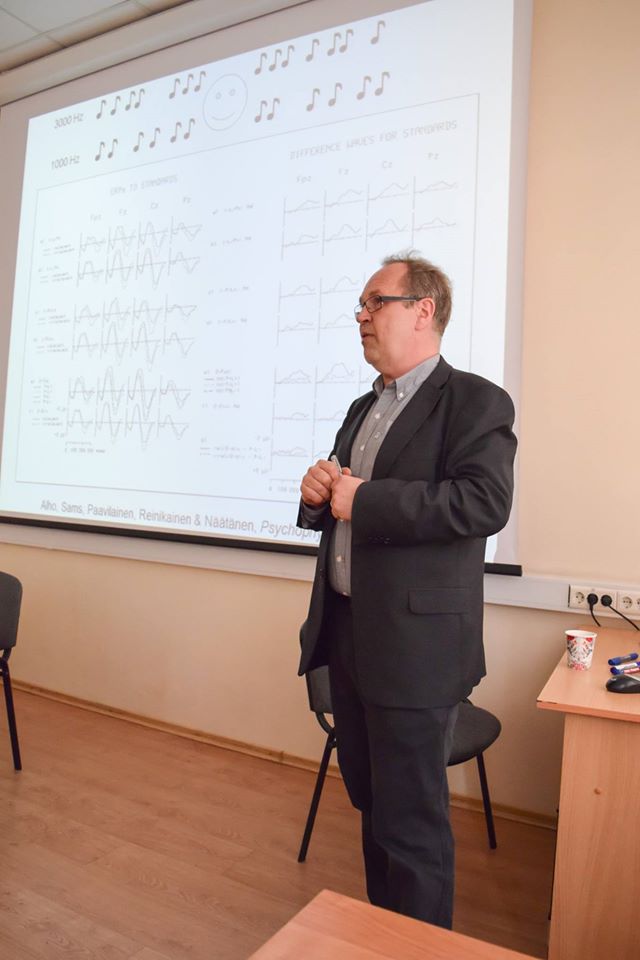Prof. Kimmo Alho gave two lectures

Lecture «Brain activity associated with voluntary and involuntary attention»
Abstract
Functional magnetic resonance imaging (fMRI) studies, as well as those of other research groups, indicate that in addition to enhanced activity in the auditory cortex, task-irrelevant physical changes in the auditory environment elicit activity in the parietal and frontal cortices. These activations are likely to be associated with bottom-up triggered, involuntary attention and they are paralleled by event-related potential (ERP) responses (the mismatch negativity and P3a) with their generators in the auditory, prefrontal, and parietal cortices. According to fMRI, top-down controlled, voluntary shifts of auditory attention are associated with activation of even wider cortical network involved largely also in maintaining attention to particular sounds. Interestingly, the brain networks for involuntary and voluntary attention may be more overlapping in the auditory modality than in the visual modality. However, according to our positron emission tomography (PET) studies, no prefrontal activity enhancement is observed during sustained selective attention to speech or written text perhaps due to life-long rehearsal of these skills. In the auditory and visual cortices, selective attention is manifested by enhanced responses to attended sounds and visual objects, as indicated by fMRI, PET, ERPs and their magnetoencephalographic (MEG) counterparts. However, our fMRI and ERP results suggest that also active suppression of processing of task-irrelevant sounds in the auditory cortex may contribute to differences between auditory-cortex responses to attended and unattended sounds.
Lecture «Brain activity and dual tasking»
Abstract
In our functional magnetic resonance imaging (fMRI) studies (Salo et al., 2013, 2015), healthy adult participants were presented with concurrent streams of spoken syllables and written letters and they performed various tasks involving the syllables or letters, or both. Selective attention to the syllables and letters was associated with activity modulations in the auditory and visual cortices, respectively. Additional activations were observed predominantly in the frontal and parietal areas for the auditory and visual tasks, respectively. For several auditory-visual dual-task combinations, division of attention between the syllables and letters was associated with left prefrontal activity enhancements presumably associated with integrating dual-task performance. Moreover, attenuated responses were observed in the auditory cortex during dual tasking (divided attention) in relation to single tasking (selective attention) perhaps due to the fact that during dual tasking, less attention was paid to the auditory inputs (cf. Alho et al., 1989). In our further study (Moisala et al., 2015), participants were presented with concurrent spoken and written sentences and they were to selectively attend to either sentence or to attend to both of them. Dual tasking involving spoken and written sentences was associated with bilateral activity enhancements in the prefrontal areas. These areas showed smaller activity enhancements during selective attention to speech and written text at the presence of task-irrelevant written text and speech, respectively, suggesting that dealing with distracting information involves same brain areas as active dual tasking. In our subsequent study applying the same experimental paradigm (Moisala et al., submitted), we found in healthy adolescents and young adults (N=149) more right prefrontal activity and less accurate performance during attention to speech or reading at the presence of irrelevant text or speech/music, respectively, the more the participants dual-tasked in their daily life according to their own report.Moreover, frequent dual-tasking in everyday situations did not predict better performance in our dual-tasking experiment. These results suggest that habitual multitasking does not develop attentional skills but rather lead to enhanced distractibility and effort in conditions demanding attention.

